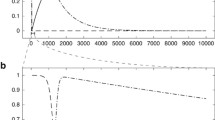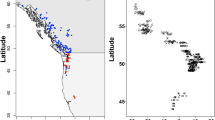Abstract
To test whether obligate apomicts can generate genetic variability, the only valid procedure is to investigate heritable variation amongst the offspring of fully agamospermous mothers. Among plants, most reports have been forTaraxacum, and this review concentrates on this genus, although there are many analogous reports for animals. InTaraxacum, within-family variation is commonly found at the levels of ploidy, aneuploidy, recombination and single gene mutation. Faulty disjunction, somatic recombination due to transposon activity, and mutation are all implicated. Although such asexual variation should generate evolutionary change, and there is clear evidence that this has occurred, evolutionary patterns will differ fundamentally from those of outcrossing sexuals. As asexual matrilineal lines cannot shed or disseminate mutational loads, three dimensional relationships are dichotomously dendroid rather than reticulate.
Similar content being viewed by others
References
Asker S. (1979): Progress in apomixis research.Hereditas 91: 231–240.
Asker S. (1980): Gametophytic apomixis: elements and genetic regulation.Hereditas 93: 277–293.
Battjes J., Menken S.B.J. &den Nijs H.C.M. (1992): Clonal diversity in some microspecies ofTaraxacum sect.Palustria (Lindb. fil.)Dahlst. from Czechoslovakia.Bot. Jahrb. Syst. 114: 315–328.
Bell G. (1982):The masterpiece of nature. The evolution and genetics of sexuality. Croom Helm, London.
Calos M.P. &Miller J.H. (1980): Transposable elements.Cell 20: 579–595.
Crease T.J. &Lynch M. (1991): Ribosomal DNA variation inDaphnia pulex.Molec. Biol. Evol. 8: 620–640.
Darlington C.D. (1939):The evolution of genetic systems. Oliver & Boyd, Edinburgh.
Dickinson T.A. &Phipps J.B. (1986): Studies inCrataegus (Rosaceae: Maloideae) XIV. The breeding system ofCrataegus crus-galli sensu lato in Ontario.Amer. J. Bot. 73: 16–130.
Fincham J.R.S. &Sastry G.R.K. (1974): Controlling elements in maize.Annual Rev. Genet. 8: 15–50.
Finnegan D.J. (1981): Transposable elements and proviruses.Nature 292: 800–801.
Ford H. &Richards A.J. (1985): Isozyme variation within and betweenTaraxacum agamospecies in a single locality.Heredity 55: 289–291.
Gadella T.W.J. (1991): Variation, hybridization and reproductive biology ofHieracium pilosella-L.Proc. Kon. Ned. Akad. Wetensch., C. 94: 455–488.
Gustafsson Å. (1935): Primary and secondary association inTaraxacum.Hereditas 20: 1–31.
Gustafsson Å. (1946–1947): Apomixis in higher plants.Acta Univ. Lund. N.S., Sect. 2. 42(3): 1–67; 43(2): 69–179, (12): 183–370.
Hoy-Liu S. (1963): The chromosome numbers of someTaraxacum species.Acta Bot. Neerl. 12: 76–83.
Hughes J. (1987):Variability in sexual and apomictic Taraxacum. Ph.D. Thesis, University of Newcastle upon Tyne, Newcastle upon Tyne.
Hughes J. &Richards A.J. (1988): The genetic structure of populations of sexual and asexualTaraxacum.Heredity 60: 161–171.
Janzen D.J. (1977): What are dandelions and aphids?Amer. Naturalist 111: 586–589.
Jenniskens M.-J. P.J., Den Nijs H.C.M. &Huizing E.A. (1984): Karyogeography ofTaraxacum sectionTaraxacum and the possible occurrence of facultative agamospermy in Bavaria and north-west Austria.Phyton (Horn) 24: 11–34.
King L.M. (1993): Origins of genotypic variability in North American dandelions inferred from ribosomal DNA and chloroplast DNA restriction enzyme analysis.Evolution 47: 136–151.
King L.M. &Schaal B.A. (1990): Genotype variation within asexual lineages ofTaraxacum officinale.Proc. Natl. Acad. U.S.A. 87: 998–1002.
Kirschner J. &Štěpánek J. (1994): Clonality as part of the evolution process inTaraxacum.Folia Geobot. Phytotax. 29: 265–275.
Lokki J., Saura A., Kankinen P. &Suomalainen E. (1976a): Genetic polymorphism and evolution in parthenogenetic animals. V.Genet. Res. 28: 27–36.
Lokki J., Saura A., Lankinen P. &Suomalainen E. (1976b): Genetic polymorphism and evolut parthenogenetic animals. VI.Hereditas 82: 209–216.
Lyman J.C. &Ellstrand N.C. (1984): Clonal diversity inTaraxacum officinale (Compositae), an apomict.Heredity 53: 1–10.
Małecka J. (1967): Cyto-embryological studies inTaraxacum scanicum Dt.Acta Biol. Cracov., Ser. Bot. 10: 195–206.
Małecka J. (1969): Further cyto-taxonomic studies in the genusTaraxacum sectionErythrosperma Dt. 1.Acta Biol. Cracov., Ser. Bot. 12: 57–70.
Manning J.T. &Dickson D.P.E. (1986): Asexual reproduction, polyploidy and optimal mutation rates.J. Theor. Biol. 118: 485–489.
Maynard Smith J. (1978):The evolution of sex. Cambridge University Press, Cambridge.
Mayr E. (1970):Populations, species and evolution. Belknap, Cambridge MA.
Mogie M. (1982):The status of Taraxacumagamospecies. Ph.D. Thesis, University of Newcastle upon Tyne, Newcastle upon Tyne.
Mogie M. (1985): Morphological, developmental and electrophoretic variation within and between obligately apomicticTaraxacum agamospecies.Biol. J. Linn. Soc. 24: 207–216.
Mogie M. (1986): On the relationship between asexual reproduction and polyploidy.J. Theoret. Biol. 122: 493–498.
Mogie M. (1992):The evolution of asexual reproduction in plants. Chapman Hall, London.
Mogie M. &Ford H. (1988): Sexual and asexualTaraxacum species.Biol. J. Linn. Soc. 35: 155–168.
Mogie M. &Richards A.J. (1983): Satellited chromosomes, systematics and phylogeny inTaraxacum (Asteraceae).Pl. Syst. Evol. 141: 219–229.
Muldal S. (1952): The chromosomes of the earthworms. I. The evolution of polyploidy.Heredity 6: 55–76.
Muller H.J. (1932): Some genetic aspects of sex.Amer. Naturalist 66: 118–138.
Muller H.J. (1964): The relation of recombination to mutational advance.Mut. Res. 1: 2–9.
Muller U. (1972): Zytologisch-embryologische Beobachtungen anTaraxacum-Arten aus der SektionVulgariaDahlst. in der Schweiz.Ber. Geobot. Inst. ETH Stiftung Rübel 41: 48–55.
Navashin M. (1926): Variabilität des Zellkerns beiCrepis-Arten in Bezug auf die Artbildung.Z. Zellf. Mikroskop. Anat. 4: 171–215.
den Nijs H.C.M., Sterk A.A. &van der Hammen H. (1978): Cytological and ecological notes on theTaraxacum sectionsErythrosperma andObliqua of the coastal area of the Netherlands.Acta Bot. Neerl. 27: 287–305.
den Nijs H.C.M., Menken B.J. & Vlot L. (1987): Gene flow in di-triploid mixed stands ofTaraxacum (Asteraceae) in the Odenwald (BRD) as measured by isozyme analysis. Abstract 5-46-9. In:XIV International Botanical Congress Abstracts, Berlin, p. 307.
Nogler G. (1994): Genetics of gametophytic apomixis—a historical sketch.Polish Bot. Stud. 8: 5–11.
Nybom H. (1988): Apomixis versus sexuality in blackberries (Rubus subgen.Rubus, Rosaceae).Pl. Syst. Evol. 160: 207–218.
Omodeo P. (1952): Cariologica dei Lumbricidae.Caryologia 4: 173–275.
van Oostrum H., Sterk A.A. &Wijsman H.J.W. (1985): Genetic variation in agamospermous microspecies ofTaraxacum sectionErythrosperma and sectionObliqua.Heredity 55: 223–228.
Proctor M.C.F., Proctor M.E. &Groenhof A. (1989): Evidence from peroxidase polymorphism on the taxonomy and reproduction of someSorbus populations in south-west England.New Phytol. 112: 569–575.
Richards A.J. (1968):The biosystematics of Taraxacum. Ph.D. Thesis, University of Durham, Durham.
Richards A.J. (1969): [Reports]. In:Löve Á., IOPB chromosome number reports XXIII.Taxon 18: 560–562.
Richards A.J. (1970): Eutriploid facultative agamospermy inTaraxacum.New Phytol. 69: 761–774.
Richards A.J. (1972a): The karyology of someTaraxacum species from alpine regions of Europe.Bot. J. Linn. Soc. 64: 47–59.
Richards A.J. (1972b): [Reports]. In:Löve Á., IOPB chromosome number reports XXXV.,Taxon 21: 165–166.
Richards A.J. (1973): The origin ofTaraxacum agamospecies.Bot. J. Linn. Soc. 66: 189–211.
Richards A.J. (1986):Plant breeding systems. Allen & Unwin, London.
Richards A.J. (1989a): A comparison of within-plant karyological heterogeneity between agamospermous and sexualTaraxacum (Compositae) as assesed by the nucleolar organizer chromosome.Pl. Syst. Evol. 163: 177–185.
Richards A.J. (1989b): The evolution of copper tolerance in apomicticTaraxacum.Apomixis Newslett. 1: 37–40.
Richards A.J. (1996): Breeding systems in flowering plants and the control of variability.Folia Geobot. Phytotax. 31: 283–293.
Saura A., Lokki J., Lankinen P. &Suomalainen E. (1976): Genetic polymorphism and evolution in parthenogenetic animals. III.Hereditas 82: 79–100.
Sørensen Th. (1958): Sexual chromosome aberrants in triploid apomicticTaraxaca.Bot. Tidsskr. 54: 1–22.
Sørensen Th. &Gudjonsson G. (1946): Spontaneous chromosome aberrants in apomicticTaraxaca.Biol. Skr. 4: 2–48.
Stebbins G.L. (1950):Variation and evolution in plants. Columbia, New York.
Sterk A. (1987): Aspects of the population biology of sexual dandelions in the Netherlands. In:Huiskes A.H.L., Blom C.W.P.M. & Rozema J. (eds.),Vegetation between land and sea, Dordrecht, pp. 284–290.
Strobel E., Dunsmuir P. &Rubin G.M. (1979): Polymorphism in the chromosomal locations of elements of the 412, copia and 297 dispersal repeated gene families inDrosophila.Cell 17: 429–439.
Suomalainen E. (1969): Evolution in parthenogeneticCurculionidae.Evol. Biol. 3: 261–296.
Suomalainen E., Saura A. &Lokki J. (1976): Evolution of parthenogenetic insects.Evol. Biol. 9: 209–257.
Woodruff R.C. &Thompson J.N. (1980): Hybrid release of mutator activity and the genetic structure of natural populations.Evol. Biol. 12: 129–162.
Woodruff R.C., Thompson J.N. &Lyman R.F. (1979): Intraspecific hybridization and the release of mutator activity.Nature 278: 277–279.
Yamaguchi S. (1978): Biosystematics vol. II. In:Proceedings of the 8th Annual Symposium on Plant Biosystematics, Shirahama, Wakayama, pp. 35–43.
Author information
Authors and Affiliations
Rights and permissions
About this article
Cite this article
Richards, A.J. Genetic variability in obligate apomicts of the genusTaraxacum . Folia Geobot 31, 405–414 (1996). https://doi.org/10.1007/BF02815385
Issue Date:
DOI: https://doi.org/10.1007/BF02815385




